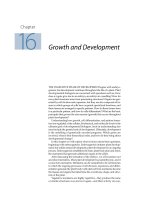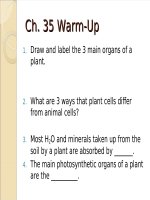Lecture Biology (7th edition) - Chapter 35: Plant structure, growth, and development
Bạn đang xem bản rút gọn của tài liệu. Xem và tải ngay bản đầy đủ của tài liệu tại đây (3.44 MB, 74 trang )
Chapter 35
Plant Structure, Growth, and
Development
PowerPoint Lectures for
Biology, Seventh Edition
Neil Campbell and Jane Reece
Lectures by Chris Romero
Copyright © 2005 Pearson Education, Inc. publishing as Benjamin Cummings
• Overview: No two Plants Are Alike
• To some people
– The fanwort is an intrusive weed, but to others
it is an attractive aquarium plant
• This plant exhibits plasticity
– The ability to alter itself in response to its
environment
Figure 35.1
Copyright © 2005 Pearson Education, Inc. publishing as Benjamin Cummings
• In addition to plasticity
– Entire plant species have by natural selection
accumulated characteristics of morphology
that vary little among plants within the species
Copyright © 2005 Pearson Education, Inc. publishing as Benjamin Cummings
• Concept 35.1: The plant body has a hierarchy
of organs, tissues, and cells
• Plants, like multicellular animals
– Have organs composed of different tissues,
which are in turn composed of cells
Copyright © 2005 Pearson Education, Inc. publishing as Benjamin Cummings
The Three Basic Plant Organs: Roots, Stems, and Leaves
• The basic morphology of vascular plants
– Reflects their evolutionary history as terrestrial
organisms that draw nutrients from two very
different environments: below-ground and
above-ground
Copyright © 2005 Pearson Education, Inc. publishing as Benjamin Cummings
• Three basic organs evolved: roots, stems, and
leaves
• They are organized into a root
system and a shoot system
Reproductive shoot (flower)
Terminal bud
Node
Internode
Terminal
bud
Shoot
system
Vegetative
shoot
Leaf
Blade
Petiole
Axillary
bud
Stem
Taproot
Lateral roots
Figure 35.2
Copyright © 2005 Pearson Education, Inc. publishing as Benjamin Cummings
Root
system
Roots
• A root
– Is an organ that anchors the vascular plant
– Absorbs minerals and water
– Often stores organic nutrients
Copyright © 2005 Pearson Education, Inc. publishing as Benjamin Cummings
• In most plants
– The absorption of water and minerals occurs
near the root tips, where vast numbers of tiny
root hairs increase the surface area of the root
Figure 35.3
Copyright © 2005 Pearson Education, Inc. publishing as Benjamin Cummings
• Many plants have modified roots
(a) Prop roots
Figure 35.4a–e
(d) Buttress roots
Copyright © 2005 Pearson Education, Inc. publishing as Benjamin Cummings
(b) Storage roots(c) “Strangling” aerial
roots
(e) Pneumatophores
Stems
• A stem is an organ consisting of
– An alternating system of nodes, the points at
which leaves are attached
– Internodes, the stem segments between nodes
Copyright © 2005 Pearson Education, Inc. publishing as Benjamin Cummings
• An axillary bud
– Is a structure that has the potential to form a
lateral shoot, or branch
• A terminal bud
– Is located near the shoot tip and causes
elongation of a young shoot
Copyright © 2005 Pearson Education, Inc. publishing as Benjamin Cummings
• Many plants have modified stems
(a) Stolons. Shown here on a
strawberry plant, stolons
are horizontal stems that grow
along the surface. These “runners”
enable a plant to reproduce
asexually, as plantlets form at
nodes along each runner.
Storage leaves
Stem
(d) Rhizomes. The edible base
of this ginger plant is an example
of a rhizome, a horizontal stem
that grows just below the surface
or emerges and grows along the
surface.
Node
Root
Figure 35.5a–d
(b) Bulbs. Bulbs are vertical,
underground shoots consisting (c)
Tubers. Tubers, such as these
mostly of the enlarged bases
red potatoes, are enlarged
of leaves that store food. You
ends of rhizomes specialized
can see the many layers of
for storing food. The “eyes”
modified leaves attached
arranged in a spiral pattern
to the short stem by slicing an
around a potato are clusters
onion bulb lengthwise.
of axillary buds that mark
the nodes.
Copyright © 2005 Pearson Education, Inc. publishing as Benjamin Cummings
Rhizome
Root
Leaves
• The leaf
– Is the main photosynthetic organ of most
vascular plants
Copyright © 2005 Pearson Education, Inc. publishing as Benjamin Cummings
• Leaves generally consist of
– A flattened blade and a stalk
– The petiole, which joins the leaf to a node of
the stem
Copyright © 2005 Pearson Education, Inc. publishing as Benjamin Cummings
• Monocots and dicots
– Differ in the arrangement of veins, the vascular
tissue of leaves
• Most monocots
– Have parallel veins
• Most dicots
– Have branching veins
Copyright © 2005 Pearson Education, Inc. publishing as Benjamin Cummings
• In classifying angiosperms
– Taxonomists may use leaf morphology as a
leaf. A simple leaf
criterion (a) isSimple
a single, undivided blade.
Some simple leaves are
deeply lobed, as in an
oak leaf.
Petiole
(b) Compound leaf. In a
compound leaf, the
blade consists of
multiple leaflets.
Notice that a leaflet
has no axillary bud
at its base.
(c) Doubly compound leaf.
In a doubly compound
leaf, each leaflet is
divided into smaller
leaflets.
Figure 35.6a–c
Copyright © 2005 Pearson Education, Inc. publishing as Benjamin Cummings
Axillary bud
Leaflet
Petiole
Axillary bud
Leaflet
Petiole
Axillary bud
• Some plant species
– Have evolved modified leaves that serve
various functions
(a) Tendrils. The tendrils by which this
pea plant clings to a support are
modified leaves. After it has “lassoed”
a support, a tendril forms a coil that
brings the plant closer to the support.
Tendrils are typically modified leaves,
but some tendrils are modified stems,
as in grapevines.
(b) Spines. The spines of cacti, such
as this prickly pear, are actually
leaves, and photosynthesis is
carried out mainly by the fleshy
green stems.
(c) Storage leaves. Most succulents,
such as this ice plant, have leaves
modified for storing water.
(d) Bracts. Red parts of the poinsettia
are often mistaken for petals but are
actually modified leaves called bracts
that surround a group of flowers.
Such brightly colored leaves attract
pollinators.
Figure 35.6a–e
(e) Reproductive leaves. The leaves
of some succulents, such as Kalanchoe
daigremontiana, produce adventitious
plantlets, which fall off the leaf and
take root in the soil.
Copyright © 2005 Pearson Education, Inc. publishing as Benjamin Cummings
The Three Tissue Systems: Dermal, Vascular, and Ground
• Each plant organ
– Has dermal, vascular, and ground tissues
Dermal
tissue
Figure 35.8
Copyright © 2005 Pearson Education, Inc. publishing as Benjamin Cummings
Ground
tissue
Vascular
tissue
• The dermal tissue system
– Consists of the epidermis and periderm
Copyright © 2005 Pearson Education, Inc. publishing as Benjamin Cummings
• The vascular tissue system
– Carries out long-distance transport of materials
between roots and shoots
– Consists of two tissues, xylem and phloem
Copyright © 2005 Pearson Education, Inc. publishing as Benjamin Cummings
• Xylem
– Conveys water and dissolved minerals upward
from roots into the shoots
• Phloem
– Transports organic nutrients from where they
are made to where they are needed
Copyright © 2005 Pearson Education, Inc. publishing as Benjamin Cummings
• Ground tissue
– Includes various cells specialized for functions
such as storage, photosynthesis, and support
Copyright © 2005 Pearson Education, Inc. publishing as Benjamin Cummings
Common Types of Plant Cells
• Like any multicellular organism
– A plant is characterized by cellular
differentiation, the specialization of cells in
structure and function
Copyright © 2005 Pearson Education, Inc. publishing as Benjamin Cummings
• Some of the major types of plant cells include
– Parenchyma
– Collenchyma
– Sclerenchyma
– Water-conducting cells of the xylem
– Sugar-conducting cells of the phloem
Copyright © 2005 Pearson Education, Inc. publishing as Benjamin Cummings
• Parenchyma, collenchyma, and sclerenchyma
cells
PARENCHYMA CELLS
COLLENCHYMA CELLS
80 m
Cortical parenchyma cells
SCLERENCHYMA CELLS
5 m
Sclereid cells
in pear
25 m
Cell wall
Parenchyma cells
60 m
Collenchyma cells
Fiber cells
Figure 35.9
Copyright © 2005 Pearson Education, Inc. publishing as Benjamin Cummings









